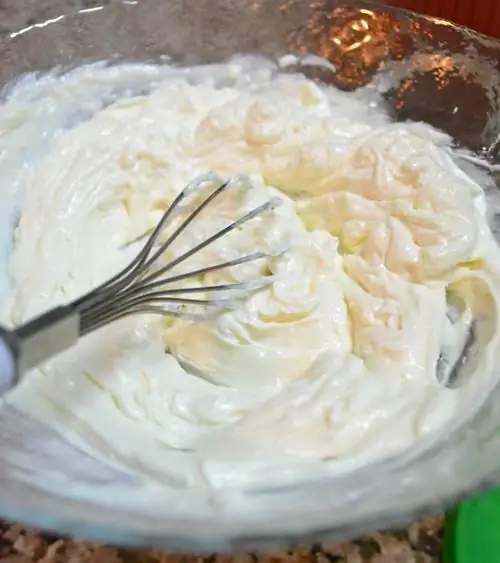2025 Author: Isabella Gilson | [email protected]. Last modified: 2025-01-23 12:50:36
Drinking milk is one of the most common products today. A wide range of these products is produced on the territory of the Russian Federation. Depending on the method of heat treatment used, several different types of product are distinguished. Each of them has its own characteristics.
Processing options
Drinking milk in Russia is processed by various thermal methods. Depending on this, the following product groups are distinguished:
- Pasteurized milk.
- Ghee.
- Sterilized.
- UHT - processed.
- UHT - processed sterilized.
The difference in the processing method also affects such product characteristics: taste, nutritional and biological value, shelf life.
However, the assortment of drinking milk does not end there. Depending on the amount of fat, solids and flavorings in the final product, they distinguish:
- Whole milk.
- Normalized.
- High fat content.
- Remanufactured (Powder).
Bdrinking milk with various additives can be distinguished as a separate group: with coffee, with cocoa and other types.
A significant difference is present in the method of packaging and packaging in which this product is sold. Milk goes on sale in transport containers, in tanks, flasks, in small packages.
One of the most important points is that GOST drinking milk sets standards for organoleptic, sanitary-hygienic, physical and chemical indicators. For each type of product, its own standards have been developed and established. All manufactured products must comply with the regulations in force at the time of their release.

Technical requirements according to GOST, physicochemical and organoleptic standards
According to the technical specifications of GOST 31450-2013, drinking milk must meet the following organoleptic requirements:
- Appearance of goods. It is an opaque liquid. For milk with a fat content of more than 4.7%, a small settling of fat is allowed. However, when stirred, it must necessarily disappear.
- The consistency of the product should be liquid, not viscous, slightly viscous. Fat lumps, protein flakes and other particles are absolutely unacceptable.
- Drinking milk according to GOST 31450-2013 must have a characteristic smell and taste for this product. Only a slight aftertaste of boiling is allowed. If milk belongs to the group of baked or sterilized products, then the taste of boiling should be pronounced in it.
- As for the color, it should bewhite. For skimmed milk, a bluish tint is allowed, light cream for sterilized, and cream for baked milk.

Specifications GOST 31450-2013 for drinking milk set the standards for its physical and chemical parameters, which we have drawn up for convenience in the form of a table.
| Name of physical and chemical characteristic | Parameter value |
| Density measured in kg/m3 | From 1024 (for full fat milk) to 1030 (for skim milk) |
| Mass fraction of protein in % (not less than) | 3, 0 |
| The acidity parameter is measured in °T (no more) | 21 for all products with a mass fraction of fat, except 4, 7; fifty; 5, 5; 6.0; 6, 5; 7.0; 7, 2; 7, 5; 8.0; 8, 5; 9.0; 9, 5. For this fat content, the acidity index is 20. |
| Permissible mass fraction of skimmed dry milk residue in% (not less than) | 8, 2 |
| For pasteurized, ghee or UHT product without aseptic filling - phosphatase or peroxidase is released | Not allowed |
| Purity Group | Not lower than the first |
|
A certain temperature of the goods must be observed during the end of its manufacture at the enterprise, ° С: for pasteurized, melted, ultra-pasteurized (without aseptic filling) |
4±2 degrees |
| The same parametertemperature, but with aseptic filling, for sterilized milk | from 2 to 25 degrees inclusive |
Requirements for raw materials according to government documents
GOST drinking milk regulates the requirements for raw materials used for the production of different groups of milk. So, for the manufacture of pasteurized and baked products use:
- Cow raw milk.
- Cream.
- Skim milk.
- Buttermilk to be obtained from the production of sweet cream butter.
GOST 31450-2013 also regulates the data of raw materials for such types of products as sterilized and ultra-pasteurized product.
Cow's milk is used here, but its acidity should not exceed 18 °T, the content of somatic cells in the product should not exceed 500 thousand/cm3, and heat resistance according to alcohol test required at least Category 3.
Skim milk and cream are also used for production. Buttermilk is also included, but the acidity of the component should not exceed 17 °T.

Beginning of the production process
The production of drinking milk according to specifications should begin with an assessment of the quality of the raw materials. This work is carried out by a specialized laboratory. If there is a positive conclusion, the raw material is allowed for further use. Acceptance of milk and other necessary components is carried out according tomass. Raw materials must be cleaned and cooled to a temperature of 4 to 6 degrees Celsius. In addition, the original products (milk, cream) must also be sorted and reserved in such a way as to ensure the continuous production of goods.
Further, according to document 31450-2014, quality-selected drinking milk must be normalized for fat percentage. The desired consistency is achieved by adding (mixing) or selecting part of the cream. All work is streamed.
The method of normalizing fat content by mixing requires strictly regulated actions. Depending on the final result, whole milk will be added:
- Fat-free if whole would be too high in fat.
- Cream, if the fat content of whole milk is inferior to the requirements of normalized milk.
To calculate the exact amount of additives required for mixing, use a separator - a cream separator. Part of the milk is separated on this equipment. During this procedure, buttermilk can be used, the amount of which will not exceed 70% of the total mass of the non-fat component used for the subsequent normalization of the whole product. These two components can be mixed together and then added to whole milk, but the amount of buttermilk in any case should not exceed 70%.

Normalization process
Production of drinking milk according to GOST specifications involvesa process called normalization.
This procedure is carried out in a stream, and the following sequence is used in it: separator-normalizer-milk cleaner. With the help of these regulated actions, it is possible to simultaneously clean and normalize the whole milk supplied to the separator from the regeneration section of the pasteurization cooling plant. The temperature of the components should be 45-60 degrees Celsius, and the amount of substance supplied depends on the level of performance of the installation itself.
This process produces cream, which is collected separately, and normalized milk. After the step described above, it will undergo homogenization and then return to the pasteurization section. According to GOST 31450-2013 and specifications, drinking milk is homogenized to improve taste. This procedure is mandatory for goods with a fat content of 3.5%, and it is also recommended to carry it out for products with a fat content of 1%, 1.5%, 2.5%, 3.2%. This procedure is unable to directly affect the taste. However, homogenization affects the viscosity of the formulation. As a result, the taste of the final product also changes.

Cleaning and following procedures after homogenization
Drinking milk according to GOST 31450-2013, the technical parameters of which are specified in this document, must undergo a purification stage. It is carried out in centrifugal milk cleaners. This stage is necessary and does not depend on the method by which milk was normalized. Cleaning takes place at a temperature40-45 degrees Celsius. Immediately after this, the product is sent for homogenization under a pressure of 12±2.5 MPa. The temperature during this process is maintained at 45 degrees Celsius. According to the technical conditions of GOST 31450 for drinking milk, it is allowed to carry out the homogenization process at the pasteurization temperature.

Product bottling
Pasteurized drinking milk is obtained by holding for about 15-20 seconds in a temperature environment of 76±2 degrees Celsius. Most often, a plate pasteurization and cooling unit is used for this procedure. However, the temperature may vary, depending on the mechanical and bacterial contamination of the feedstock. One of the convenient features of plate pasteurization and cooling units is the ability to record a thermogram, which indicates the temperature at which the pasteurization was carried out.
This function allows you to accurately monitor the effectiveness of this procedure carried out during the production process. The thermogram is stored for a year from the date of its release.
Production of drinking milk involves the use of automatic installations. So, in automatic mode, the pasteurization temperature is controlled and changed. In addition, this equipment is equipped with a locking system and a check valve. These details do not allow the unpasteurized product to leave the plant. If the process is not completed, the milk is separately removed to a special intermediate (balancing)tank. It will be re-delivered to the pasteurization chamber with new portions of the raw product.
After passing through this procedure and subsequent cooling to 6 degrees Celsius, the finished milk enters for bottling and capping or in an intermediate tank. It is allowed to store the product for 6 hours. In some cases, it happens that due to production needs, milk is stored longer. In this case, it should be re-pasteurized before bottling and capping. In addition, the total shelf life of such a product is reduced by the period that it was in the intermediate container after 6 hours.
According to regulatory documents, milk contains quite little vitamin C. This substance is easily oxidized, a significant part of it is lost during processing. Therefore, in order to enrich the product with vitamin C, fortified milk is produced. It is slightly more expensive than usual, but still in high demand. Another separate category is drinking UHT milk. This product is distinguished by the fact that the temperature for its processing is maintained even higher than for ordinary milk. As a result, any living microorganisms die in it. For this reason, it is often referred to as sterilized.

Baked and reconstituted milk
To obtain baked milk, it is necessary to process it in a special tank. In this case, tubular pasteurizers are used. They allow you to heat the feedstock up totemperature 95-98 degrees Celsius.
It is after heating and placing in a special container for heating that milk is kept for a certain time. 3-4 hours are needed for a product with a fat content of 4 and 6%, and 4-5 hours for a product with a fat content of 1%. Low-fat raw materials are aged for the same amount of time so that it acquires a creamy hue. Here it is important to take into account one feature - after cooling the baked milk, its color will be more saturated, that is, dark.
During the infusion in the tanks, it is necessary to periodically stir the product. This is necessary to avoid the appearance of a film and sedimentation of fat.
Ready baked milk is cooled to 8 degrees Celsius and packaged in consumer packaging. Then it is cooled to 4-6 degrees Celsius in refrigerators. The period of storage and sale after the end of the technological process is 36 hours, including the period of storage in production, which is no more than 18 hours.
Reconstituted milk is developed and produced separately. It should be noted here that the following raw materials can be used for its production:
- Whole milk.
- Whole dry.
- Dry Skim.
The last version also uses dry buttermilk. It is important to note here that such a product in terms of its organoleptic, physico-chemical, sanitary and hygienic standards should not differ from the usual one. The production of such milk, as a rule, is resorted to in those areas where climatic conditions do not allow breeding and keeping cattle.
Working with dry ingredients
It is worth noting that the technological process and its sequence in the manufacture of milk from dry ingredients is almost no different from working with conventional raw materials. The only and significant difference is its preparation, that is, the restoration of dry components.
In this case, the evaluation of the quality of raw materials and its acceptance is that it is necessary to check the solubility of the powder, as well as its physical and chemical properties. In the manufacture of pasteurized milk from dry ingredients, they must be of high quality. Get them by spraying.
All dry raw materials intended for recovery must be sieved. After that, it is dissolved in hot (45-60 degrees Celsius) drinking water of the highest quality. To carry out the recovery process, special units with a mixing function are usually used in production. So that the prepared mixture does not turn out to be too acidic, it must be cooled immediately after preparation to 5-8 degrees Celsius.
At this temperature, products are kept for 3 to 4 hours. During this time, the proteins swell, the watery taste is eliminated, and the desired density is achieved. The end of the aging process is set by the density of milk at a temperature of 20 degrees Celsius. After that, a study of the chemical composition is carried out. If necessary, the product is normalized to the desired value.
Milk with additives
Today, the dairy industry is well developed. In addition to manufacturinga product familiar to everyone, companies are engaged in the production of milk with various special additives. It can be sugar, coffee, cocoa, fruit or fruit juices. If coffee or cocoa is used as an additional component, then milk is produced in accordance with the technical specifications TU 10-02-02-789-11-89.
The technological process for obtaining this product is similar to the production of a pasteurized product, but with the difference that at the end it is necessary to add additional components to the composition. This requires a slight correction in the manufacturing process of the manufacturing modes.
Conclusion
All milk needs careful quality control. It is carried out throughout the entire production process, as well as after its completion. The data of all checks are always entered into a special laboratory control log. After that, a special certificate is issued for each batch, allowing its implementation. Therefore, you can safely buy milk in retail chain stores. The main thing is to make sure that the expiration date indicated on each package is not violated.
We got acquainted with how the production of all types of milk is currently carried out.
Recommended:
Interesting facts about milk. Milk can turn sour during a thunderstorm. Frog in milk. Invisible milk ink

From childhood, everyone knows that milk is an extremely he althy product. In ancient times, it was even considered a cure for many diseases. Why does milk turn sour during a thunderstorm. Why do you need to put a frog in it. Which animal has the fattest milk? Why adults shouldn't drink it. We bring to your attention the most interesting facts about milk
Conditions and shelf life of pasteurized milk. The benefits of milk for the human body

What will be the shelf life of pasteurized milk depends on the conditions in which it will be. It is also important whether the package with milk is opened or hermetically sealed and has not been opened. If you brought a dairy product from the store sealed in an airtight container, then it will last longer
Drinking regimen: organization and rules. Organization of drinking regime at school or kindergarten

Drinking regimen is an essential component in human life. Its organization should be clearly established both at home and at work, in kindergartens and schools
Mastic from condensed milk. Milk mastic on condensed milk. Mastic with condensed milk - recipe

You can, of course, go to the store and buy ready-made cake decorations from marshmallows, glucose and glycerin. But, firstly, all these garlands, beads and bows with flowers do not bear a trace of your individuality and creative imagination, and secondly, they are not cheap. Therefore, today we will learn how to make mastic from condensed milk
Goat milk for pancreatitis: vitamins, minerals and nutrients in milk, the pros and cons of drinking, its effect on the body and doctor's advice

Products made from this milk are recommended for dietary nutrition, because they contain a large number of various mineral compounds, and in addition, valuable proteins along with vitamins. However, these foods are low in calories. It is allowed to take goat's milk with pancreatitis, and in addition, with some other diseases. What useful components are included in this medicinal product?

